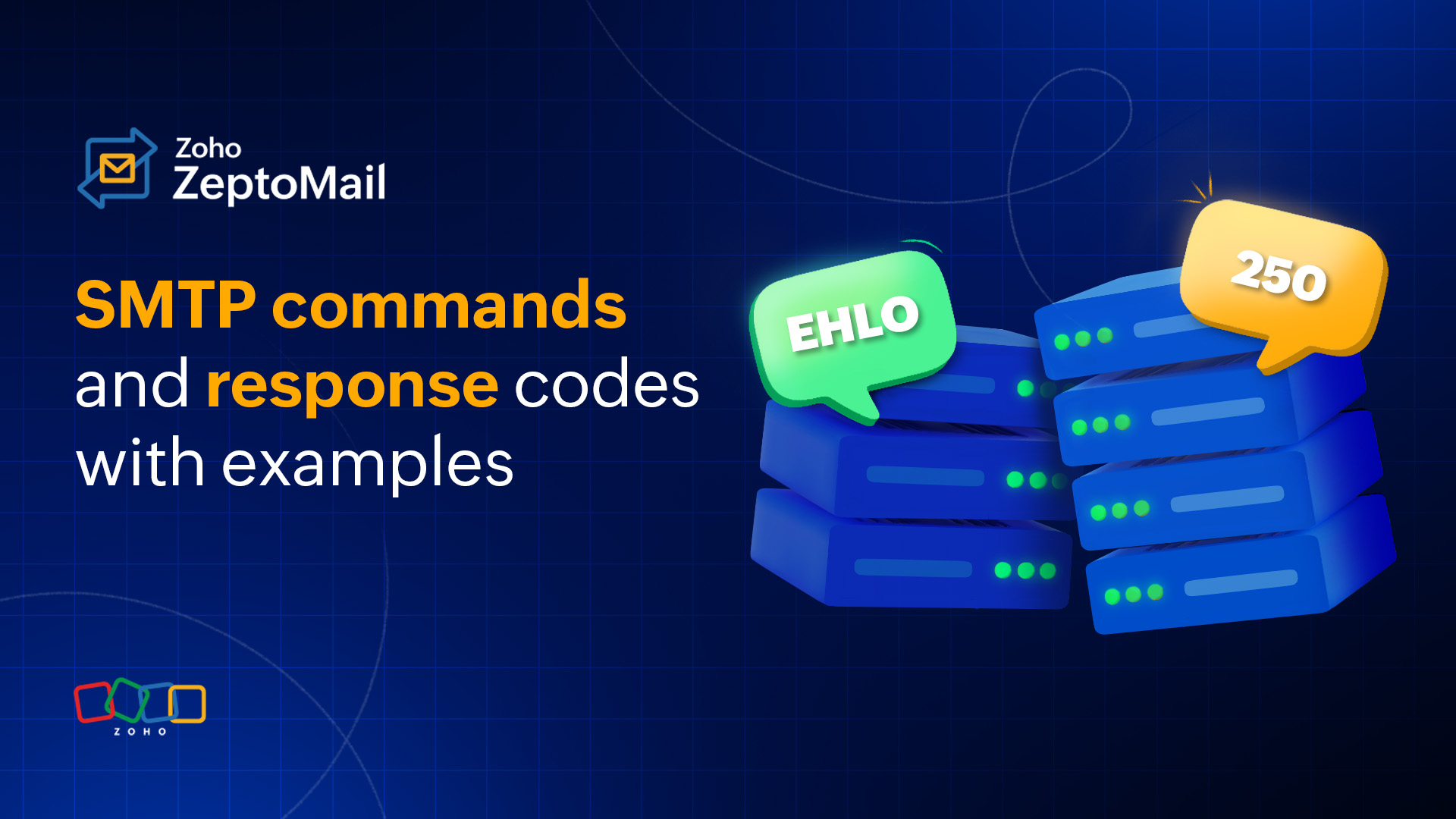- HOME
- Email sending
- How do you measure the performance of transactional emails?
How do you measure the performance of transactional emails?
- Published : November 9, 2023
- Last Updated : November 17, 2025
- 797 Views
- 8 Min Read
Businesses send many types of emails, but when it comes to measuring their performance, the focus and conscious efforts are more often than not reserved for marketing email. This is mostly because it is easy to visualize the conversion of the marketing email performance into sales or actual revenue.
The emails that are often sidelined and taken for granted are the ones that are most important to a business's brand image—transactional emails. Monitoring the performance of transactional emails and taking corrective action is crucial. Getting transactional email delivery right might not convert to actual revenue, but getting them wrong can cause you to lose business and revenue.
Of all the emails you send from your business, transactional emails are the only ones that are triggered by your user's action. At the end of their interaction with you, you send a transactional email to acknowledge it. Every user expects that your business gets this right. They expect these emails in their inbox and they expect them to arrive instantly. Failure to deliver these emails within a very short timeframe negatively impacts your brand image, customer trust, and, ultimately, customer retention.
To avoid this negative impact, measuring the performance of transactional emails must be a priority rather than an afterthought for every business looking to grow.
Now that we know that measuring the performance is important, how do we do it? When it comes to transactional emails, there are some key parameters that you can use to gauge their performance. In this article, we’ll see what these parameters are and some of the corrective measures you can take.
Let's look at these performance metrics in two broad categories—performance at the recipient server and performance with users.
Performance at the recipient server
These metrics are indications of how your email is treated by the recipient server even before it reaches your user.
Sent/Processed emails
This metric denotes the number of transactional emails that your server has tried sending to your recipients. While this number by itself won't necessarily measure the email performance, it will give you an idea of different business activities. More welcome emails means more sign ups, an increase in order confirmation emails means more revenue, and so on.
When it comes to transactional email performance, the "processed" metric is only important in combination with other metrics that follow, like delivered, bounces, click-through, and unreads.
Delivered emails
The delivered count is the number of emails sent from your server that were successfully accepted by the recipient's server. Simply sending out good email volumes isn't enough. The primary goal of any email is to reach the recipient. This is truer in transactional email delivery than for other emails. The delivered emails metric is a measure of how well you're fulfilling the primary purpose. If you need to pick one metric to focus on, this is the one.
If the sent-to-delivered ratio is high, you have nothing to worry about, but what if it isn't? This means that a significant number of your important transactional emails are being rejected by the recipient's server. There are many reasons for this rejection, but there are a few basic corrective measures you can take to resolve this, which we discuss below.
Email authentication protocols
The first step of any receiving server is to check for certain domain records. Having the right records published is the most basic checkbox to tick.
SPF specifies the email servers that are allowed to send your emails.
DKIM ensures that the message was from the original sender and not intercepted by an impersonator.
DMARC advises receiving servers on what to expect with the SPF and DKIM records and what action to take when either or both of these authentications fail.
IP reputation
Your email's ability to be delivered is a consequence of your IP reputation. The better the reputation, the better the deliverability. Pick a transactional email sending service that manages sending IPs well and can ensure good practices among their users.
If you're using a dedicated IP, the responsibility is completely yours, which means you need to rectify your email sending practices.
Domain reputation
Your sending domain's reputation is another major piece of the sender reputation puzzle. Ensure that the domain you use for sending transactional emails isn’t shared with your promotional emails. By isolating the domain, you can ensure that the reputation stays intact.
When using email tracking, use a custom tracking domain that's different from your email sending domain.
If your delivered emails ratio doesn’t improve even after taking these corrective measures, you need to focus on the next metric on this list—bounces.
Read our deliverability guide on some tips to improve deliverability.
Bounced emails
This is the metric that requires immediate attention. Bounced emails are all of the emails that your recipient's server refused to accept from you. When the bounced emails rate is high, you’re failing to relay important and time-sensitive information to your customers.
There are two types of bounces:
Soft bounces: Emails that are bounced due to temporary reasons like a full mailbox or recipient email policy.
Hard bounces: Emails that are bounced due to permanent reasons like wrong email address or the recipient doesn’t exist.
You’ll need to take different measures to rectify both types of bounces.
Soft bounces
Emails can be bounced when the message size is high. Optimize your email and attachments to be as minimal in size as possible.
If your emails are getting blocked due to recipient's content or spam policies, ensure that your content is clean and raises no red flags.
In some cases, emails get bounced because of reasons out of your control, like the mailbox being full, inactivity, or because the recipient server is down. If this is happening too often for some recipients, reduce the frequency of sending email to these recipients.
Hard bounces
It’s important to employ the double opt-in method so you can verify that the email address you have is correct.
Use the suppression list to block sending emails to recipient email addresses that cause bounces frequently or for permanent reasons. This helps keep your bounce rate low by eliminating these email addresses.
Delivery time
This metric is more relevant to transactional emails than any other type of email. Transactional email delivery needs to be optimized for instant delivery in contrast to promotional emails that are optimized for maximum engagement.
Because it acts as an acknowledgement for a transaction, your users expect quick delivery. Scrutinizing the time it takes for your emails to reach different email providers can help you improve your delivery time.
Performance with users
Let's say all of your corrective measures worked and your email has been delivered. What next? Now, you need to check how it performs inside the user’s inbox.
Open rates
This metric denotes the number of emails that have been opened by your users once they’ve reached their inboxes. Though transactional emails are essential emails, they may not always be opened. Sometimes they’re ignored, but sometimes they’re missed.
You can take some measures to ensure that your email doesn't get lost in the sea of emails that your user receives every day. So, how can you improve open rates for transactional emails?
- Your display name should clearly state your name and your company name, or just your company name. For example, "Nikki from Zoho ZeptoMail" gives them a clear indication of who the message is from.
- Optimize your subject line to clearly and precisely state the purpose of the email without including any promotional content. Users are more likely to open "Welcome to ZeptoMail" than "Save $$ with ZeptoMail."
- Another way to stand out from the crowd is by using the Brand Indicators for Message Identification (BIMI) practice that is increasingly being adopted by businesses. It allows you to display your logo right next to your email.
- A sudden decrease in open rates could mean that your emails are ending up in the spam folder. Ensure that your SPF and DKIM records are in place and your email contains only relevant content.
Click-through rates
You can go one step further in measuring your transactional email performance using this metric.
Not all open emails are read completely. Transactional emails often contain important call to action (CTA) buttons. Knowing if users are clicking on these links can be helpful in determining user behavior in your emails. Some links might be more important to track than others, but there are some measures you can take to improve the click-through rate:
- First, focus on creating good content that’s relevant to your users. Analyze your audience’s behavior and create content that is tailored for different groups of users.
- When you have enough data on the devices and browsers that your customers use to access your email, you can optimize your content and design it specifically for those devices.
- Finally, use A/B testing to figure out which content or design works best. These are the most common and most important metrics that can be used to gauge the performance of your transactional email.
Measure transactional email performance with Zoho ZeptoMail
Any good transactional email provider should be able to provide you with the tools required to view and analyze these performance metrics. ZeptoMail gives you deep insight into every single email sent from the platform.
Email analytics overview:

You can group emails using Mail Agents. You can view the delivery status of every email sent from the processed email logs within every Mail Agent. Processed, delivered, and process failed are the available statuses.
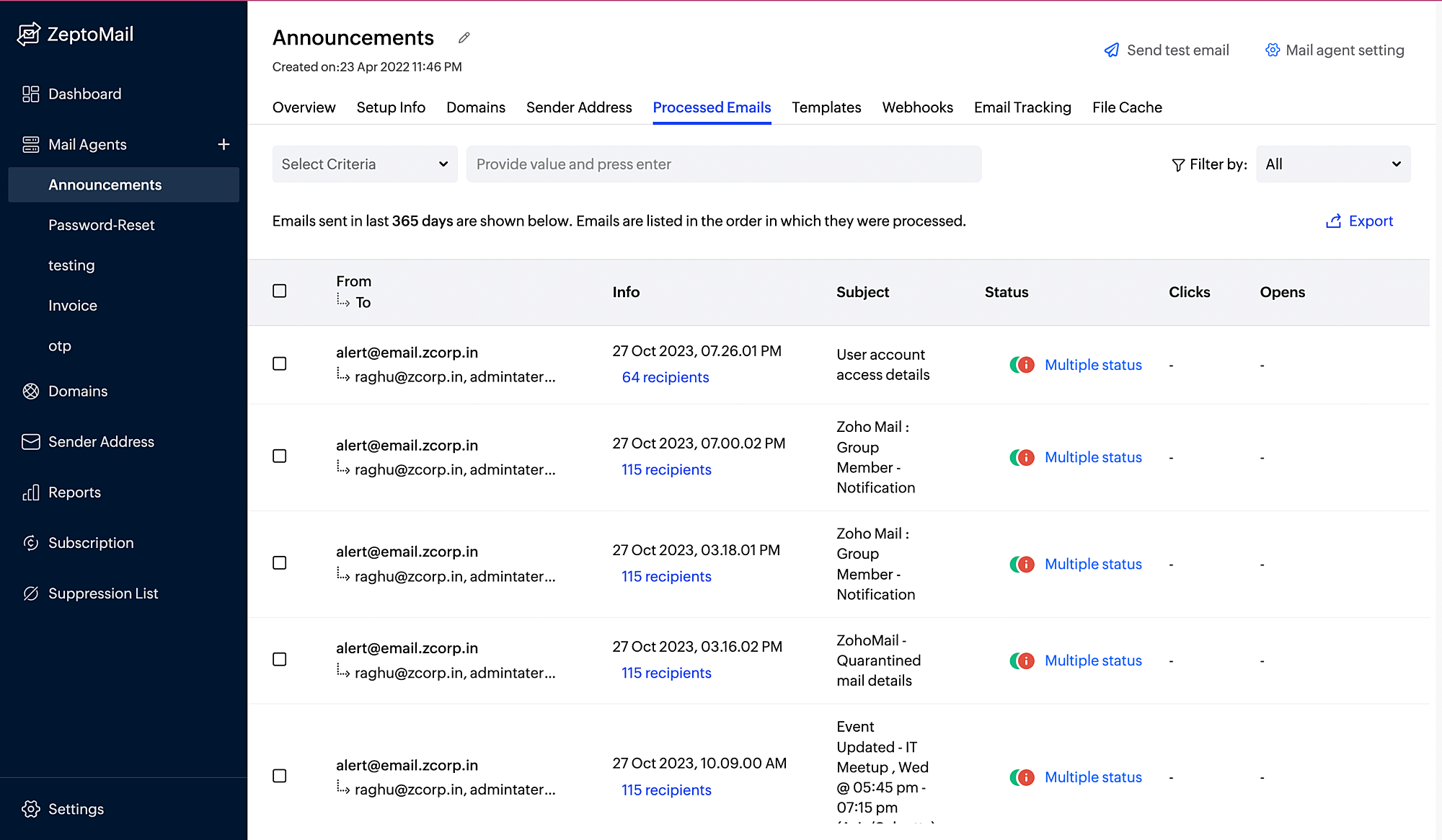
You can view the reasons for every bounced email as detailed reports, and you can also view the frequency of each reason using the bounce categories overview.
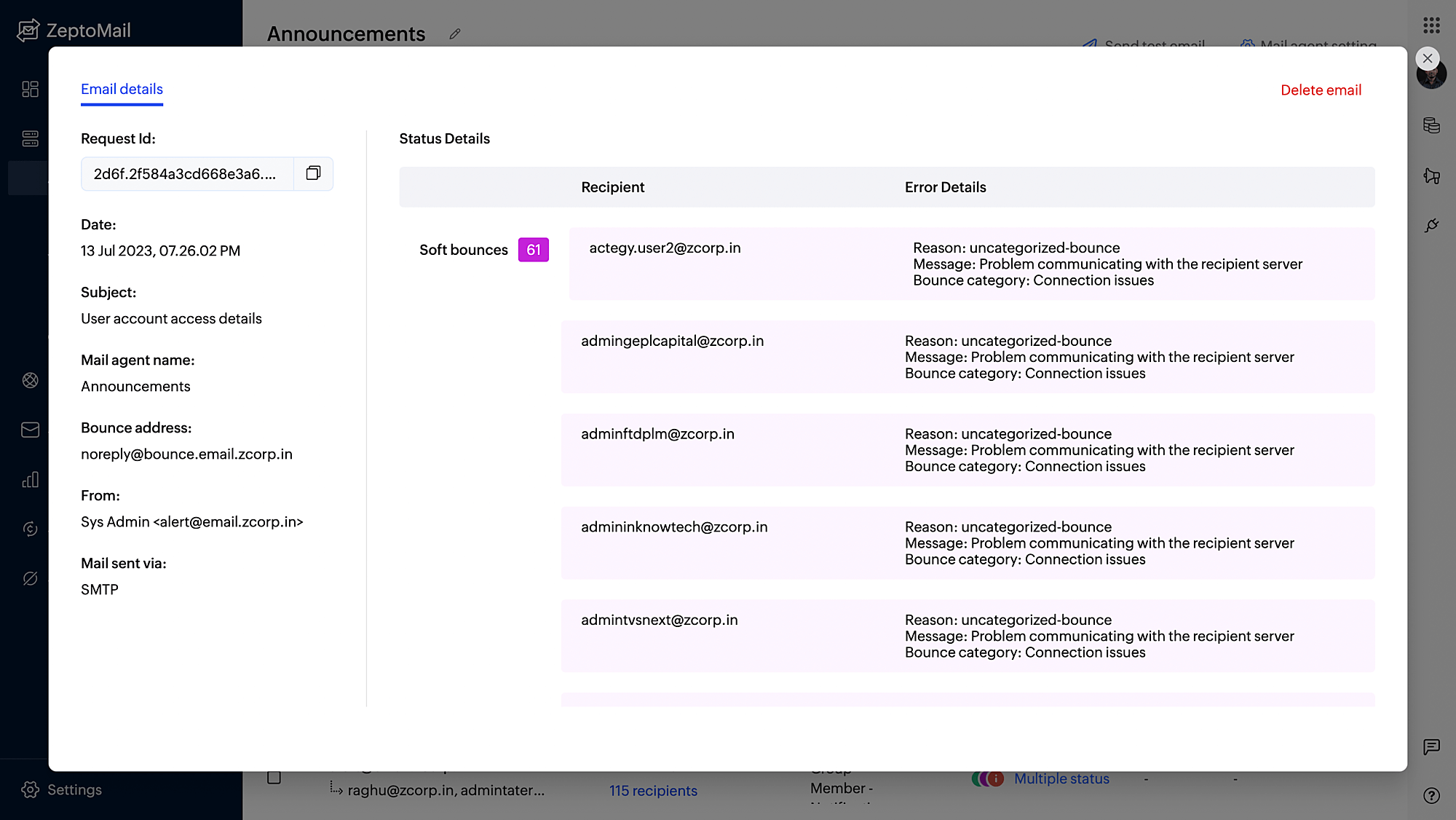
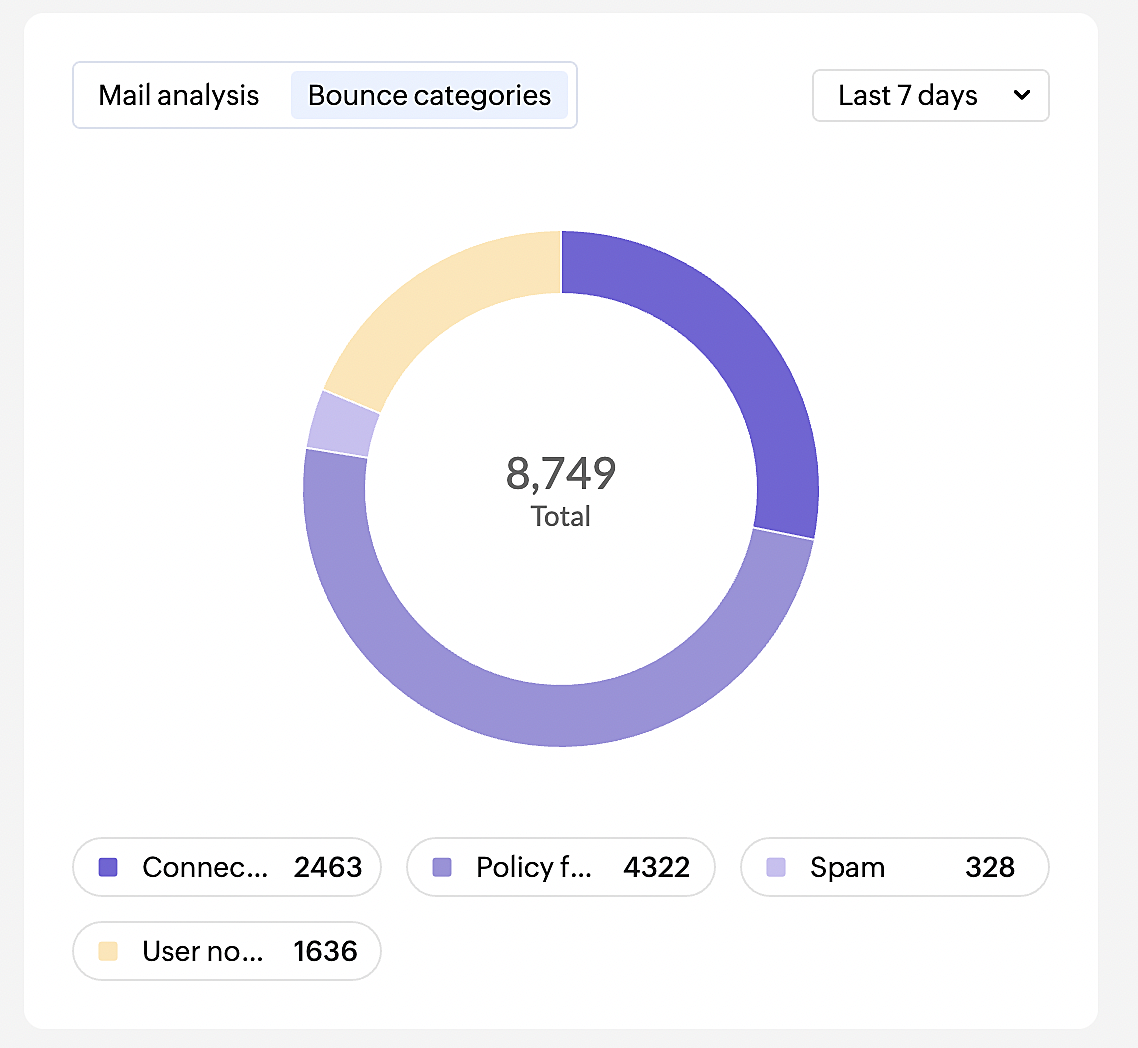
You can enable email tracking to view the data on open and clicks to see how your users interact with the email.

Data on the browsers, devices, operating systems, and email clients indicates how the users access your emails. This helps with customizing your emails to the most used channels.
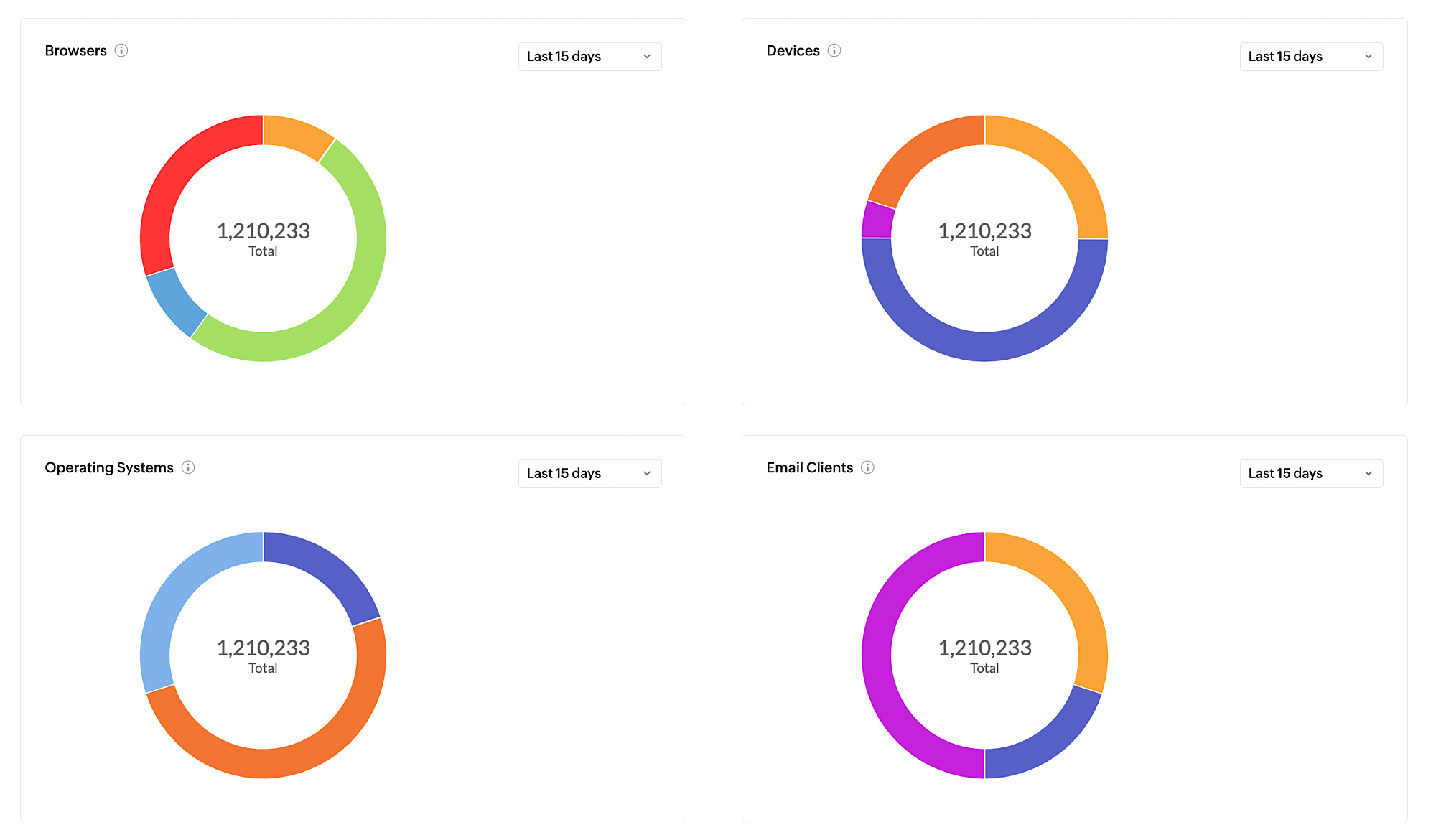
You can create reports comparing these different metrics between two or more Mail Agents to see which group of emails is performing better. You can then adopt the practices from the well-performing email group into other groups.
Webhooks can help keep you informed of these occurrences on a public URL of your choice. Email delivery status and recipient activity can be notified to the destination URL you've chosen.

Conclusion
Because transactional emails are automated emails with no intention of promotion or sales, they’re often taken for granted. Getting their delivery right may not show a visible return on investment, but failure to get it right will have a negative impact on your brand. This makes it critical to measure the performance of these emails.
The metrics we’ve discussed will help you gauge your emails’ performance. It starts with picking a service that equips you with this data. Zoho ZeptoMail is a platform that focuses exclusively on transactional email delivery and arms you with comprehensive insights and reports into every email you send to us.
